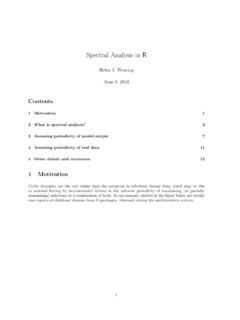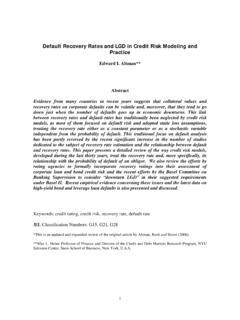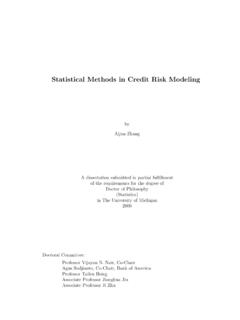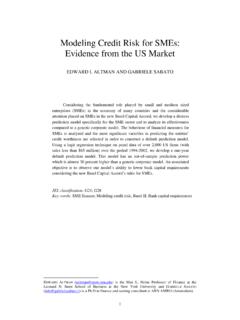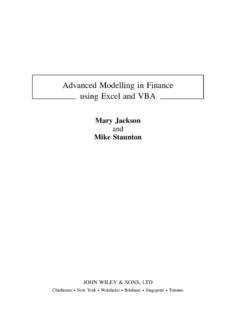Transcription of Math 774 - Credit Risk Modeling - McMaster …
1 math 774 - Credit Risk ModelingM. R. Grasselli and T. R. HurdDept. of Mathematics and StatisticsMcMaster UniversityHamilton,ON, L8S 4K1 March 31, 20102 Contents1 Types of Financial Risk .. The Nature of this Book ..72 Bond Market Default-free bonds and default-free interest rates .. Defaultable bonds and Credit spreads .. Interest Rate and Credit Derivatives .. Bonds and floating rate notes .. Interest rate swaps .. Credit Default Swaps .. Options on bonds .. Exponential Default Times .. Exercises ..203 Modeling of Interest Differentials.
2 One Factor Short Rate Models .. Market price of risk .. Affine Models .. The Vasicek Model .. The Dothan Model .. The Exponentiated Vasicek Model .. The Cox Ingersoll-Ross Model .. Fitting the initial term structure .. Parameter Estimation and the Initial Term Structure .. The Ho Lee Model .. The Hull White Extended Vasicek Model .. Deterministic Shift Extensions .. Forward Rate Models .. General Option Pricing Formulas .. Exercises ..3834 CONTENTS4 Structural Models of Credit The Merton Model (1974) .. Black-Cox model.
3 Time-Changed Brownian Motion Models .. KMV .. Optimal Capital Structure Models .. Default Events and Bond Prices .. Unconditional default probability .. Conditional default probability .. Implied Survival Probabilities and Credit Spreads .. Exercises ..535 Reduced Form Information Sets .. Basic examples of reduced form models .. Poisson processes .. Inhomogeneous Poisson processes .. Cox processes .. Definition of reduced form models .. Constructing reduced form models .. Construction A .. Construction B .. Simulating the default time.
4 Affine Intensity Models .. CIR Intensities .. Mean-reverting intensities with jumps .. Risk-neutral and physical measures .. Exercises ..696 Further Reduced Form Recovery Models .. Bankruptcy in the US Code .. Recovery Fraction .. Recovery of par .. Recovery of treasury .. Recovery of market value .. Stochastic recovery models .. Two-factor Gaussian models .. General Two Factor Models .. Credit Derivatives .. Credit Default Swaps .. CDS Pricing under Recovery of Market Value .. Credit Rating Models .. Discrete-time Markov chain.
5 Continuous-time Markov chain .. Exercises ..867 Portfolio Credit Credit Risk Basics .. A Single Obligor .. Multiple Obligors .. Economic Capital .. Market Risk .. Modeling Dependent Defaults .. The Binomial Expansion Technique .. Default Correlation in Structural Models .. CreditMetrics Approach .. First Passage Models .. Factor Models of Correlation .. Default correlation in reduced-form models .. Doubly stochastic models .. Joint default events .. Infectious defaults .. Hawkes Processes .. Definition of Copula Functions.
6 Fr echet bounds .. Normal Copula and Student t-Copula .. Tail dependence .. Archimedean copulas .. One factor normal copula default model .. An example of default Modeling with copulas [NOT COMPLETE] . Exercises ..1088 CDOs and other basket Credit to default derivatives .. First to Default Swap .. Swaps .. First-m-to-Default Swap in Normal Copula Models .. Nonhomogeneous Probabilities: Recursion Algorithm .. Index Credit Default Swaps .. Collateralized debt obligations .. Pricing CDOs in Copula Models .. Some specific CDOs.
7 Pricing a Homogeneous CDO .. Pricing a Nonhomogeneous CDO .. Pricing CDOs with Varying Notionals .. Exercises ..119A Mathematical It o diffusions .. The Strong Markov Property and the Markov Generator .. It o Formula .. The Feynman-Kac Formula .. Kolmogorov Backward Equation .. Ornstein-Uhlenbeck Processes .. Girsanov Theorem .. Arbitrage Pricing Theory .. Change of Numeraire .. First Passage Time for Brownian Motion with Drift .. Multivariate Normal Distributions .. Exercises ..131 Chapter Types of Financial RiskDuffie and Singleton [8] identify five categories of risk faced by financial institutions: Market risk: the risk of unexpected changes in prices; Credit risk: the risk of changes in value due to unexpected changes in Credit quality,in particular if a counterparty defaults on one of their contractual obligations; Liquidity risk: the risk that costs of adjusting financial positions may increase sub-stantially; Operational risk: the risk that fraud, errors or other operational failures lead to lossin value.
8 Systemic risk: the risk of market wide illiquidity or chain reaction rough classification reflects the wide ranging character of risk as well as the methodsindustry uses to manage them. But clearly the classification is very blurry: for example,the risk that Credit spreads will rise can be viewed as both a form of market risk and aform of Credit order to keep focus, this book will to a great extent restrict attention to marketand Credit risk, where the Credit risk component will almost always refer to medium tolarge corporations. We will adopt the philosophy that because the drivers of Credit riskare strongly correlated with drivers of market risk, it is important to deal with the jointnature of market and Credit risk, and therefore the careful risk manager should not try toseparate The Nature of this BookThe primary aim of this book is to provide a coherentmathematicaldevelopment ofthe theory that describes fixed income markets, both in the default-risk-free and the78 CHAPTER 1.
9 INTRODUCTION default-risky settings, that will allow the rigorous pricing, hedging and risk managementof portfolios of government and corporate bonds. By extension, however, we must alsoaddress the Modeling of Credit derivatives, that is contingent claims written on creditrisky underliers. To maintain mathematical clarity, we will confine discussion of pointsof industrial or financial background to Remarks , separated from the main body of thetext. These remarks are needed for a correct interpretation of the mathematical results,but not for the logical development.
10 Questions concerning mathematical foundationsor related mathematical issues that can be considered elementary or tangential to themain line will often be dealt with in Appendix A. Examples given in the text provideillustrations of the central mathematical notions, but are not necessary for the strictlogical development. However, of central interest to mathematicians are the definitions, Modeling hypotheses, and propositions: these we will highlight as best as we can in thebody of the otherwise stated, we consider a probability space ( ,F,P) equipped with afiltration (Ft)t 0satisfying the usual conditions of right-continuity and have the meaning of the physical or historical measure; other relevantmeasures equivalent toP, for example the risk-neutral measureQ, will also be sigma-algebraFtwill usually have the meaning of the full market information avail-able at timet.




